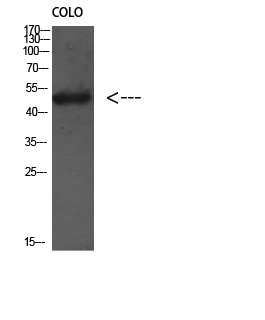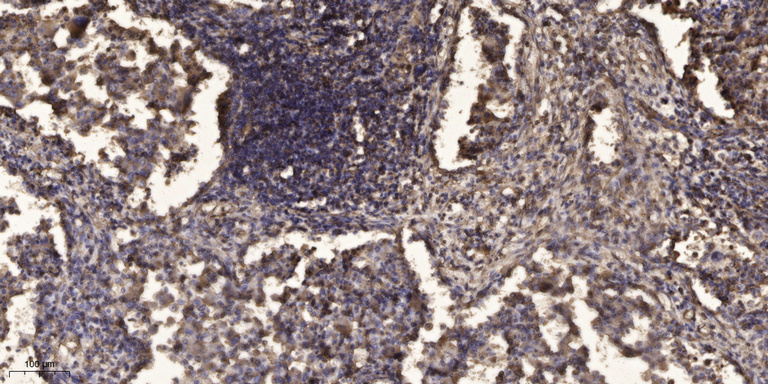Atg4D Polyclonal Antibody
- Catalog No.:YT0396
- Applications:WB;IHC;IF;ELISA
- Reactivity:Human;Mouse
- Target:
- Atg4D
- Fields:
- >>Autophagy - other;>>Autophagy - animal
- Gene Name:
- ATG4D
- Protein Name:
- Cysteine protease ATG4D
- Human Gene Id:
- 84971
- Human Swiss Prot No:
- Q86TL0
- Mouse Swiss Prot No:
- Q8BGV9
- Immunogen:
- Synthesized peptide derived from the Internal region of human Atg4D.
- Specificity:
- Atg4D Polyclonal Antibody detects endogenous levels of Atg4D protein.
- Formulation:
- Liquid in PBS containing 50% glycerol, 0.5% BSA and 0.02% sodium azide.
- Source:
- Polyclonal, Rabbit,IgG
- Dilution:
- WB 1:500 - 1:2000. IHC 1:100 - 1:300. ELISA: 1:5000.. IF 1:50-200
- Purification:
- The antibody was affinity-purified from rabbit antiserum by affinity-chromatography using epitope-specific immunogen.
- Concentration:
- 1 mg/ml
- Storage Stability:
- -15°C to -25°C/1 year(Do not lower than -25°C)
- Other Name:
- ATG4D;APG4D;AUTL4;Cysteine protease ATG4D;AUT-like 4 cysteine endopeptidase;Autophagin-4;Autophagy-related cysteine endopeptidase 4;Autophagy-related protein 4 homolog D
- Observed Band(KD):
- 45kD
- Background:
- Autophagy is the process by which endogenous proteins and damaged organelles are destroyed intracellularly. Autophagy is postulated to be essential for cell homeostasis and cell remodeling during differentiation, metamorphosis, non-apoptotic cell death, and aging. Reduced levels of autophagy have been described in some malignant tumors, and a role for autophagy in controlling the unregulated cell growth linked to cancer has been proposed. This gene belongs to the autophagy-related protein 4 (Atg4) family of C54 endopeptidases. Members of this family encode proteins that play a role in the biogenesis of autophagosomes, which sequester the cytosol and organelles for degradation by lysosomes. Alternative splicing results in multiple transcript variants. [provided by RefSeq, Jul 2013],
- Function:
- enzyme regulation:Inhibited by N-ethylmaleimide.,function:Cysteine protease required for autophagy, which cleaves the C-terminal part of either MAP1LC3, GABARAPL2 or GABARAP, allowing the liberation of form I. A subpopulation of form I is subsequently converted to a smaller form (form II). Form II, with a revealed C-terminal glycine, is considered to be the phosphatidylethanolamine (PE)-conjugated form, and has the capacity for the binding to autophagosomes.,similarity:Belongs to the peptidase C54 family.,tissue specificity:Mainly expressed in skeletal muscle and, to a lower extent, in testis.,
- Subcellular Location:
- [Cysteine protease ATG4D]: Cytoplasm .; [Cysteine protease ATG4D, mitochondrial]: Cytoplasm . Mitochondrion matrix . Imported into mitochondrial matrix after cleavage by CASP3 during oxidative stress and cell death. .
- Expression:
- Widely expressed in testis.
- June 19-2018
- WESTERN IMMUNOBLOTTING PROTOCOL
- June 19-2018
- IMMUNOHISTOCHEMISTRY-PARAFFIN PROTOCOL
- June 19-2018
- IMMUNOFLUORESCENCE PROTOCOL
- September 08-2020
- FLOW-CYTOMEYRT-PROTOCOL
- May 20-2022
- Cell-Based ELISA│解您多样本WB检测之困扰
- July 13-2018
- CELL-BASED-ELISA-PROTOCOL-FOR-ACETYL-PROTEIN
- July 13-2018
- CELL-BASED-ELISA-PROTOCOL-FOR-PHOSPHO-PROTEIN
- July 13-2018
- Antibody-FAQs
- Products Images

- Western Blot analysis of Colo using Antibody diluted at 1:1000. Secondary antibody(catalog#:RS0002) was diluted at 1:20000

- Immunohistochemical analysis of paraffin-embedded human Squamous cell carcinoma of lung. 1, Antibody was diluted at 1:200(4° overnight). 2, Tris-EDTA,pH9.0 was used for antigen retrieval. 3,Secondary antibody was diluted at 1:200(room temperature, 45min).



